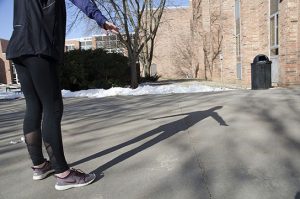Braille: beginnings to now
Braille has been around for 197 years. Today January is named National Braille Literacy month in order to honor its inventor, and also discuss the continued importance of Braille.
Braille has a set of rules just like any other system of writing, such as putting one dot (called dot 6) before a letter if it is to be capitalized.
February 6, 2018
In general, technology can make lives easier for people with a variety of disabilities. For instance, the visually impaired now have computers that can read to them and audio books they can listen to. Therefore, in this age of technology people question the importance of Braille. Katy Ring is a teacher for the visually impaired section of the Iowa Educational Services for the Blind and Visually Impaired.
“We get this question all the time and it kind of makes me laugh because you wouldn’t tell people who read print that because we have computers that are available to speak to us that they shouldn’t be able to read print. Braille and Literacy is so important,” Ring said
To celebrate and promote the importance of Braille, January was labeled National Braille Literacy Month, as it was the month Louis Braille, the inventor, was born.
Louis Braille was born in France in 1809. After a tragic accident when he was young left him completely blind, his family still sent him to the town school with his peers. However, the Braille family soon realized how a visual impairment affects education.
“You think about everything a student has access to in school. They have to be able to access their textbooks, worksheets, the board the teacher is writing on, charts that are on the wall. A [visually impaired] student cannot see any of that,” Ring said.
Louis Braille was sent to the Institute for Blind Youth in Paris. At this school, they used embossed writing which was very inefficient as the letters were hard to distinguish from each other. Then in 1821, the institute was introduced to sonography or “night writing.” A form of communication used by French soldiers to communicate at night without a sound. This also had its issues as it was not really designed for spelling since its dots were based on sounds. Braille took on the mantle of improving the system. After many years and setbacks, his six-dot cell code, now know as Braille became widely excepted. Even spreading outside its native France to become the method used in English-speaking countries.
Today, the United States has the Library of Congress National Library Service for the Blind and Physically Handicapped. Through local cooperating libraries, they mail books to people who are unable to read a standard book for a number of reasons. This is special because many smaller libraries do not offer books in Braille, such as the Coralville Public Library.
“We don’t have any books in Braille here. People who are getting Braille books get them through the Iowa Library for the Blind which is a special library in Des Moines. So usually, if you are looking for Braille, books you go through them. They have a great collection,” said Laura Cossett, Adult Services Coordinator.
The Iowa Library for the Blind mails the Braille books to customers at no cost. This allows them to have a larger collection and more variety to choose from then if the Coralville Library were the only source.
In the Iowa City Community School District, Braille is taught to those who are determined by an individual education plan team to need it. According to Dr. Denise Yoder, Assistant Director of Special Education, the amount and intensity vary by student to meet their needs.
This is taught by traveling teachers employed by Grant Wood AEA. Therefore visually impaired students will be able to have their material translated into Braille. Since by law, they must be provided access to these materials at the same time as everyone else.
“It is important for students with visual impairments to have access to Braille because this is their access to literacy and writing,” Yoder said.
Braille is not considered a rejection of computers. They can both be used, and neither has to replace the other. In Iowa City School district, students also have access to different technology that helps them read along with Braille.
“Students have the ability to access all textbooks and other educational materials through Bookshare as well as Google Read and Write,” Yoder said.
Braille is a way for the visually impaired to have the same opportunity to read as people without any visual disability. It gives them the freedom to be able to read the same books and understand the same concepts as everyone else.
“I know I really enjoy being able to grab my book off my nightstand and read the book myself and not have anyone help me do it. Braille allows our kids and blind adults to do,” Ring said.
Timeline by Ting Gao.







